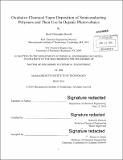| dc.contributor.advisor | Karen K. Gleason. | en_US |
| dc.contributor.author | Borrelli, David Christopher | en_US |
| dc.contributor.other | Massachusetts Institute of Technology. Department of Chemical Engineering. | en_US |
| dc.date.accessioned | 2014-10-21T17:23:18Z | |
| dc.date.available | 2014-10-21T17:23:18Z | |
| dc.date.copyright | 2014 | en_US |
| dc.date.issued | 2014 | en_US |
| dc.identifier.uri | http://hdl.handle.net/1721.1/91057 | |
| dc.description | Thesis: Ph. D., Massachusetts Institute of Technology, Department of Chemical Engineering, 2014. | en_US |
| dc.description | Cataloged from PDF version of thesis. | en_US |
| dc.description | Includes bibliographical references. | en_US |
| dc.description.abstract | Organic photovoltaics (OPVs) have received significant interest for their potential low cost, high mechanical flexibility, and unique functionalities. OPVs employing semiconducting polymers in the photoactive layer have traditionally been fabricated almost exclusively with solution-based techniques due to a lack of suitable alternatives. This has thus limited polymer solar cells and other polymer electronic devices to using polymers that are soluble. Here we explore the use of oxidative chemical vapor deposition (oCVD), a vacuum-based method, for the deposition of semiconducting polymers. Polymer deposition by oCVD occurs at moderate vacuum (~0.1 Torr) and low temperature (25 - 150°C). oCVD offers the well-cited processing benefits of vacuum processing, including parallel and sequential deposition, well-defined thickness control and uniformity, and inline integration with other standard vacuum processes (e.g. vacuum thermal evaporation). Various semiconducting polymers, including insoluble polymers that are difficult to process using conventional methods, are successfully deposited via oCVD by changing the monomer precursor. The optoelectronic properties of unsubstituted polyisothianaphthene (PITN) and unsubstituted polythiophene (PT) are first investigated under various oCVD deposition conditions. Higher stage temperatures are shown to increase conjugation in PITN films, resulting in a significant red-shift in the absorption spectrum and a decrease in the optical bandgap from 1.14 to 1.05 eV. The effects of oCVD chamber pressure on the properties of PT are then investigated. Higher chamber pressures are found to correlate with greater conjugation, increased absorption, and larger field effect mobilities in PT films. oCVD PT films are then successfully integrated into planar heterojunction OPVs as the electron donor layer, achieving power conversion efficiencies up to 0.8%. Several alternative device architectures are investigated as means to improve OPV device performance. Promisingly, a ternary energy cascade device architecture is shown to more than double the OPV device performance to over 2%. | en_US |
| dc.description.statementofresponsibility | by David Christopher Borrelli. | en_US |
| dc.format.extent | 155 pages | en_US |
| dc.language.iso | eng | en_US |
| dc.publisher | Massachusetts Institute of Technology | en_US |
| dc.rights | M.I.T. theses are protected by copyright. They may be viewed from this source for any purpose, but reproduction or distribution in any format is prohibited without written permission. See provided URL for inquiries about permission. | en_US |
| dc.rights.uri | http://dspace.mit.edu/handle/1721.1/7582 | en_US |
| dc.subject | Chemical Engineering. | en_US |
| dc.title | Oxidative chemical vapor deposition of semiconducting polymers and their use In organic photovoltaics | en_US |
| dc.type | Thesis | en_US |
| dc.description.degree | Ph. D. | en_US |
| dc.contributor.department | Massachusetts Institute of Technology. Department of Chemical Engineering | |
| dc.identifier.oclc | 892060010 | en_US |
